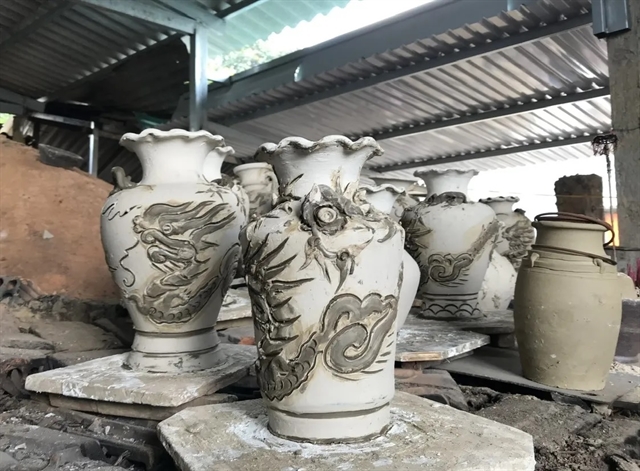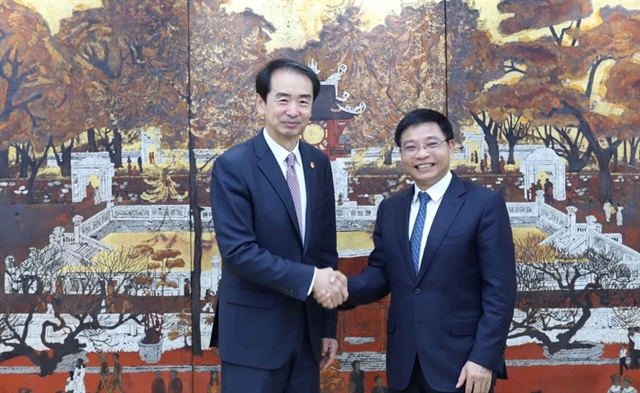 Life & Style
Life & Style


|
| Some of the Mỹ Thiện ceramic products before burning. The Mỹ Thiện ceramic craft village has a long history, dating back to the 17th century. Photo dulichvn.org.vn |
HÀ NỘI The Mỹ Thiện ceramic craft, one of the long-standing traditional occupations closely associated with the cultural life and livelihood of local people in the central province of Quảng Ngãi, has been recognised as the National Intangible Cultural Heritage.
The Ministry of Culture, Sports and Tourism issued a decision on Monday, announcing the recognition of ancient pottery in Mỹ Thiện Village, Bình Sơn Commune, as a new national intangible cultural heritage under the traditional craft criteria.
Famous in the central region for its unique pottery products, the village craft has developed very early, dating back to the beginning of the 17th century, and produces beautiful and subtle items such as pots, jars, ornamental pots, vases, and teapots.

|
| Artisan Đặng Văn Trịnh still preserves the traditional method of making Mỹ Thiện ceramic products. Photo baovanhoa.vn |
Craftsmen in the village have applied the technique of making glaze to their pottery production since the 19th century. However, the ancient technique was now threatened to fade away as very few villagers could still preserve it.
Artisan Đặng Văn Trịnh, 60, and his family members are the only ones who keep the occupation using traditional methods in production.
Trịnh and his wife have been persistent in their profession, from kneading clay, shaping, painting, to firing and selling, the couple themselves do all stages.
He said that he has been involved with pottery since he was a child, when his father passed on a piece of clay and his first lesson in the craft began.
Through his father, Trịnh learned that more than 200 years ago, people with family names as Phạm and Nguyễn from Thanh Hóa Province came to Quảng Ngãi to start a business and built the first kilns in Mỹ Thiện, laying the foundation for the pottery craft.
"They (the ancestors) chose the land along the Trà Bồng River to settle down to be convenient for trade and developing the craft. Initially, most villagers' daily work was farming, but thanks to learning from skilled craftsmen, they gradually changed to pottery," Trịnh said.
"The Co ethnic minority people from the mountain region by Trà Bồng used to make rafts of firewood and float down the river, both selling firewood and ordering jars to brew rice wine.”

|
| A villager working with clay to produce a Mỹ Thiện ceramic product. Photo quangngaitv.vn |
Trade between the mountains and the plains has been going on for hundreds of years.
Every December, the people from the mountain come down to the village to order terracotta jars.
In a workshop, Phạm Thị Thu Cúc, Trịnh's wife was busy working with the clay while listing the orders that are about to be delivered to customers, such as more than 500 mortars, over 200 wine jars, 50 to 70 vases, and many types of lime pots, teapots, enamel pots, etc.
“Although the times have changed, the patterns on Mỹ Thiện pottery still retain their traditional style and design. A five-clawed dragon is embossed in the Lý dynasty style, symbolising nobility and sacredness," Trịnh said.
"A bamboo branch symbolises a gentleman, upright, and also means luck and prosperity. A mouse is associated with the image of "a mouse falling into a jar of sticky rice". It is a symbol of abundance and prosperity.”
According to Trịnh, in Mỹ Thiện Village, each household has its own way of creating dragon shapes, but he keeps the old way his father has left to him.
The artisan arranged each product near or far from the fire, adjusting the glaze ratio to create the desired colour. After 48 hours of continuous burning, each product has a unique, changing glaze colour - that is the attraction for collectors.
The provincial authorities currently recognises Trịnh's ceramic products as 3-star OCOP and is completing the approval procedures for 4-star OCOP.
At his production house, he also set aside an area for students to visit and experience the process of making ceramics, contributing to the education and promotion of the craft value.
His products are mainly sold to restaurants, hotels, and resorts that tend to be environmentally friendly and close to nature.
“I am teaching my son the craft. I hope he will nurture a love for the craft so that when my wife and I are old and weak, he can continue and the pottery village will still have people to preserve the soul of ceramic of Mỹ Thiện - a place that has been on fire for over 200 years," Trịnh said.
The pottery village and its products were once recorded in a petition by Quảng Ngãi Mandarin Nguyễn Bá Trác, who sent them to King Bảo Đại. The information about the village was also published in the then-famous Nam Phong magazine in 1933.
According to documents, including funeral orations and folklore, artisans from the village were once invited to the Nguyễn Lord's Palace to create exquisite pottery for the royal family and as gifts. VNS




